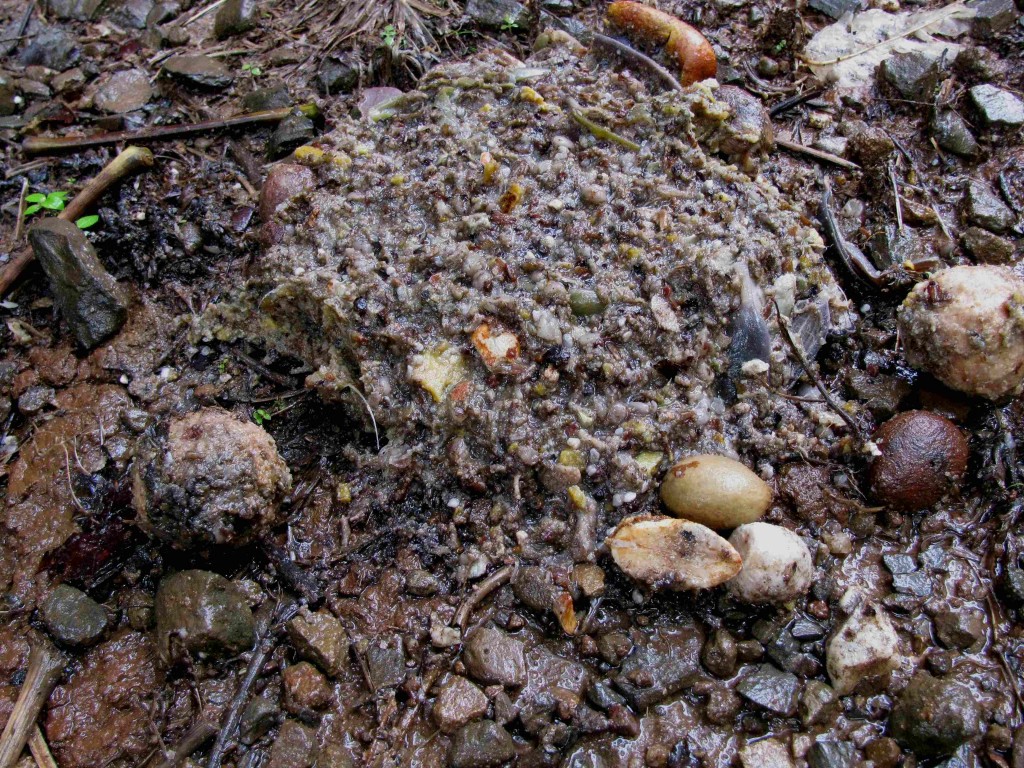
Seed-filled Cassowary Scat on McNamee Track, Misty Mountains (© Vilis Nams)
I’ve long been aware that fruit-eating birds disperse seeds, but the southern cassowary, that heavy-bodied, blue-and-red-headed dweller of North Queensland rainforests, takes seed-dispersal to a whole new plane, or should I say plop. Scats of this rainforest fruit specialist are huge and packed with a variety of seeds, as Vilis, Janis, and I observed when we encountered one on the track to McNamee Creek in the Misty Mountains in early May. Initially, I wondered if the pale, soggy, seed-studded mass was regurgitated food, but later came to the conclusion that it was a scat washed into a sodden mess by the kind of heavy downpours we encountered while bushwalking that track. It is one thing to read on an interpretive sign in Billabong Sanctuary that cassowaries eat 150 kinds of fruits, subsequently dispersing their seeds through the rainforest, and quite another to encounter some of that dispersal right before your very eyes. However, biology types are thrilled by such findings and even go so far as to display photographs of them to the unsuspecting public or to use them as portals into the ecology of the rainforest.
In mid-afternoon, after hours glued to my writing desk, I cycled to the uni to hear a lecture via video-conferencing from the Cairns campus of James Cook University. The seminar was titled “Movement Ecology: Multiple Approaches, Questions and Ecosystems” and was presented by Dr. Britta Denise Hardesty of the CSIRO Tropical Forest Research Centre in Atherton (CSIRO being the acronym for Australia’s national science agency, the Commonwealth Scientific and Industrial Research Organisation). Although Dr. Hardesty’s talk flitted from one to another of numerous studies done during the past decade, I was quite taken with the fact that one of her current studies is focused on cassowaries and their role as seed dispersers. The study, conducted in the rainforest near Mission Beach on the Queensland coast northeast of Tully, makes use of cassowary scats to determine not only where cassowaries have been and how they use the landscape, but also which rainforest trees are fruiting. Dr. Hardesty was even able to identify individual cassowaries through DNA fingerprinting of intestinal cells sloughed off and excreted along with the scats. This allowed her to determine how many cassowaries are in the area (about a dozen), to track movement patterns of individual birds via their droppings, and to determine that cassowaries are good indicators of the fruit resources available in the forest and offer an effective means of seed dispersal for rainforest plants.
On our rainforest hikes, I’ve noticed fruits of an astonishing array of shapes, sizes, and colours fallen to the forest floor. Some are bright pink, some purple, some a beautiful blue. It’s a comforting thought that cassowaries – which neither Vilis nor I have yet seen – in North Queensland rainforests are consuming fruits like those and acting the role of Johnny Appleseed. Their efforts are aided and abetted by other frugivorous birds (fruit consumers) such as parrots, fruit-doves and forest pigeons. Vilis, Janis, and I saw a beautiful wompoo fruit-dove – gorgeous shades of green, gold, grey, burgundy, and rust – in the rainforest surrounding Lake Eacham on the Atherton Tablelands in early May, and I’ve spotted sulphur-crested cockatoos, brown cuckoo-doves and top-knot pigeons high in the rainforest canopy at Paluma, all fulfilling their ecological niche as seed dispersers and, thus, maintainers of tropical rainforest diversity.


